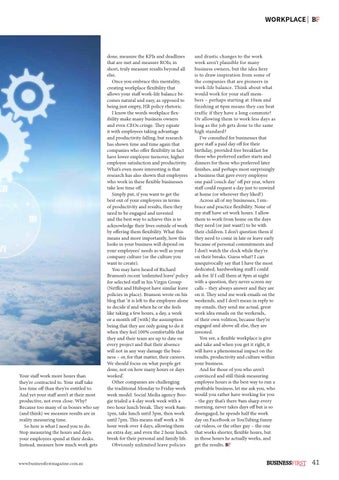WORKPLACE| BF
Your staff work more hours than they’re contracted to. Your staff take less time off than they’re entitled to. And yet your staff aren’t at their most productive, not even close. Why? Because too many of us bosses who say (and think) we measure results are in reality measuring time. So here is what I need you to do. Stop measuring the hours and days your employees spend at their desks. Instead, measure how much work gets www.businessfirstmagazine.com.au
done, measure the KPIs and deadlines that are met and measure ROIs; in short, truly measure results beyond all else. Once you embrace this mentality, creating workplace flexibility that allows your staff work-life balance becomes natural and easy, as opposed to being just empty, HR policy rhetoric. I know the words workplace flexibility make many business owners and even CEOs cringe. They equate it with employees taking advantage and productivity falling, but research has shown time and time again that companies who offer flexibility in fact have lower employee turnover, higher employee satisfaction and productivity. What’s even more interesting is that research has also shown that employees who work in these flexible businesses take less time off. Simply put, if you want to get the best out of your employees in terms of productivity and results, then they need to be engaged and invested and the best way to achieve this is to acknowledge their lives outside of work by offering them flexibility. What this means and more importantly, how this looks in your business will depend on your employees’ needs as well as your company culture (or the culture you want to create). You may have heard of Richard Branson’s recent ‘unlimited leave’ policy for selected staff in his Virgin Group (Netflix and Hubspot have similar leave policies in place). Branson wrote on his blog that ‘it is left to the employee alone to decide if and when he or she feels like taking a few hours, a day, a week or a month off [with] the assumption being that they are only going to do it when they feel 100% comfortable that they and their team are up to date on every project and that their absence will not in any way damage the business – or, for that matter, their careers. We should focus on what people get done, not on how many hours or days worked’. Other companies are challenging the traditional Monday to Friday work week model. Social Media agency Boogie trialed a 4-day work week with a two hour lunch break. They work 8am1pm, take lunch until 3pm, then work until 7pm. This means staff work a 36 hour week over 4 days, allowing them an extra day, and even the 2 hour lunch break for their personal and family life. Obviously unlimited leave policies
and drastic changes to the work week aren’t plausible for many business owners, but the idea here is to draw inspiration from some of the companies that are pioneers in work-life balance. Think about what would work for your staff members – perhaps starting at 10am and finishing at 6pm means they can beat traffic if they have a long commute? Or allowing them to work less days as long as the job gets done to the same high standard? I’ve consulted for businesses that gave staff a paid day off for their birthday, provided free breakfast for those who preferred earlier starts and dinners for those who preferred later finishes, and perhaps most surprisingly a business that gave every employee one paid ‘couch day’ off per year, where staff could request a day just to unwind at home (or wherever they liked!) Across all of my businesses, I embrace and practice flexibility. None of my staff have set work hours. I allow them to work from home on the days they need (or just want!) to be with their children. I don’t question them if they need to come in late or leave early because of personal commitments and I don’t watch the clock while they’re on their breaks. Guess what? I can unequivocally say that I have the most dedicated, hardworking staff I could ask for. If I call them at 9pm at night with a question, they never screen my calls – they always answer and they are on it. They send me work emails on the weekends, and I don’t mean in reply to my emails, they send me actual, great work idea emails on the weekends, of their own volition, because they’re engaged and above all else, they are invested. You see, a flexible workplace is give and take and when you get it right, it will have a phenomenal impact on the results, productivity and culture within your business. And for those of you who aren’t convinced and still think measuring employee hours is the best way to run a profitable business, let me ask you, who would you rather have working for you – the guy that’s there 9am sharp every morning, never takes days off but is so disengaged, he spends half the work day on FaceBook or YouTubing funny cat videos, or the other guy – the one that works shorter, flexible hours, but in those hours he actually works, and get the results. BF
BUSINESSFIRST MAGAZINE
41
